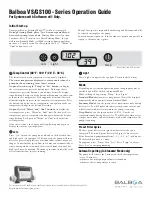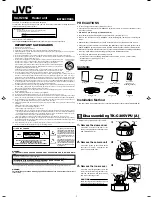
Repeater-EnO868SELV
EnOcean Repeater 868 MHz
Repeater-EnO868USB
Read the operating instructions carefully before commissioning.
Installation and operating instructions
Rev.: February 2016
Repeater-EnO868_104126_OperationManual_E_FEB2016.doc/pdf
Page 5 of 7
BootUp GmbH
|
Sonnenbergstrasse 23
|
CH-5236 Remigen
|
Switzerland
|
Phone +41 56 284 09 21
|
Fax +41 56 284 09 22
2016
|
Omi technical changes excepted
|
www.BootUp.ch
|
www.myHomeControl.ch
|
Radio range is restricted by:
•
Leaded glass or glass with metal coating, steel furniture
•
Moisture in materials increase damping
•
Hollow lightweight walls with insulating wool on metal foil
•
False ceilings with metal or carbon fibre panels
•
When mounting the transmitters on metal surfaces: Please do not mount the receiver in the same plane
(same wall) as the metal surface significantly reduces the propagation of the signals in this plane.
•
Fire walls, lift shafts, staircases and supply areas should be considered as separation.
•
Keep close to objects made of metal or materials with metal components, minimum distance of 10 cm.
•
Devices which also operate with high-frequency signals, e.g. Computers, audio / video systems, electronic
transformers and electronic ballasts (ECGs) for lamps, etc. are considered as other sources of interference.
The minimum distance to these devices should be 0.5m.
More
information
EnOcean
Wireless
Systems
–
RANGE
PLANNING
GUIDE(PDF)
.
www.enocean.com/fileadmin/redaktion/pdf/white_paper/WP_RANGE_PLANNING_May09_en.pdf
The radio range can be extended by the use of radio amplifiers, an EnOcean repeater (e.g., Repeater-
EnO868SELV or Repeater-EnO868USB). When planning the retrofitting of repeaters should be considered
(power connection).
Measurement of radio quality:
For verification of the installation and during optimization or troubleshooting, the EnOcean signals can be easily
and reproducibly simulated and measured with test equipment (e.g. P30 see
www.probare.biz
). Please visit
www.myHomeControl.ch
.
Fault diagnosis, error analysis and rectification
For a new plant or an existing plant:
•
Check whether the green <Power> LED is lit.
•
Check the reception function by sending (press PTM button) the yellow LED <Radio> must flash briefly.
•
Check if changes have been made in the environment of the system that cause interference (for example,
metal cabinets, furniture or walls have been moved, etc.).
•
If the transmitting unit / receiver works at a reduced distance, they are disturbed or used outside the
transmission range.
•
Placement of the transmitting unit at a more favourable location or use of another radio repeater.
•
Check the mains voltage of the actuators.
•
Check whether the actuator is correctly connected.
•
Check the function of the connected loads.
•
Delete all learned transmitters in the actuator and reprogram the actuator.
The actuator switches ON or OFF:
•
This can happen if an other transmitter is operated within the reception area, which was previously also
trained on the actuator.
Delete all learned transmitters in the actuator and reprogram the actuator.
Transmitter does not work:
•
Take the transmitter and move in the direction of the actuator. If the system operates at a reduced distance,
the
transmitter
has
been
mounted
outside
the
transmission
range,
or
is
disturbed.
Mount transmitter / actuator in a more convenient location.
Repeaters will increase the radio traffic
Actuators and permanently powered sensors can perform not only the actual function but also the repeater
function. This can have undesirable effects as the radio traffic is increased with each repeater. If you make
observations that you can not explain, then a suitable instrument can provide the appropriate insight.
Note: Repeaters should only be used if necessary!

























